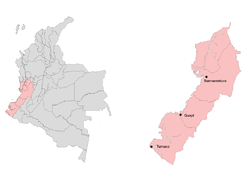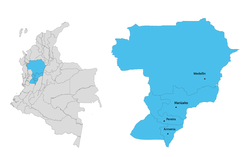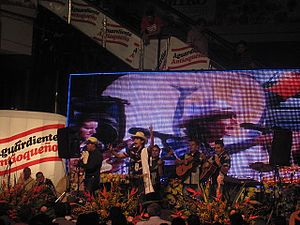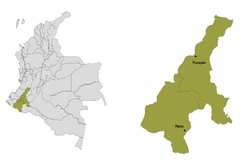Musical axes of Colombia
The Musical Axes of Colombia are the set of cultural regions whose folk music shares common genres, musical styles, and instrumentation formats. The fact that such different genres can currently be appreciated if those of one axis are compared with those of another is due in large part to the abrupt geography of the Colombian territory that for several centuries isolated the different regions, keeping them almost incommunicado.. With the passing of time, the regions witnessed the fusion of races, peoples and cultures, the result of political, social and economic situations, which were shaping the aesthetic conceptions of each society that inhabited the country, becoming very frequent the discovery of styles musical instruments with different instrumentation, harmony and melodies on each axis.
Throughout the history of Colombia it has been perceived how the different musical axes have "relevant" prominence from a musical point of view. This has meant that each generation has associated different musical genres as more representative for the country. With the passing of time and thanks to technological advances that have greatly impacted the development of musical instruments, we see how some of these genres have been modified, merged, and reinvented. However, it is still very common to find these rhythms in their purest essence in each of the musical axes.
Today it is considered that there are 12 musical axes in the country, cataloged with those names by the Musical Documentation Center of the National Library of Colombia, with the exception of the axis of the inter-Andean valleys of the Pacific. In the past it was considered that in Colombia there were only five musical regions that were limited to appreciating the geographical aspects of the country. The study of traditional folk music through these musical axes is conceived as a great advance in the search for recognition, training and safeguarding of the nation's musical heritage.
Twelve musical axes
Western Caribbean Hub
This axis includes the Colombian departments on the western continental Caribbean, namely Atlántico, Bolívar, Córdoba and Sucre, and also musically the banks of the Magdalena River in the departments of Magdalena and Cesar. His musical practices are the consequence of the mixture of European, Amerindian and black traditions. During the XX century with the development of the big bands, various musical genres were exploring new directions, with different instrumentations and melodic and harmonic variations. The Carnival of Barranquilla is one of the folkloric events where the rhythms of this musical axis are most exploited. From this region comes one of the best-known musical genres of Colombia in the world: La cumbia.
- Instrumental formatting
- Group of millo
- Crank of a thousandth or a thousandth flute
- Merry Tambor
- Tambor caller
- Tambora
- Guache
- Maracas
- Papayera
- Redoblante
- Bombo
- Plates
- Clarinete
- Bombardino
- Trumpet
- Trombón
- Chord assembly
- Acorde
- Caja vallenata
- Merry Tumbadora or Tambor
- Guacharaca
- Tambor caller
- Group of gaitas
- Gaita male
- Female cat
- Short cat (single)
- Merry Tambor
- Tambor caller
- Tambora
- Maracas
- Maracon
- Lemon leaf
- Picó champagneetero
- Computer
- Speakers
- Gender
Eastern Caribbean Hub
This axis includes the Colombian departments on the eastern continental Caribbean, namely Guajira, Magdalena and Cesar. His musical practices have developed during the XX century and have become popular throughout Colombia and other Latin American countries for the second part of this century and the XXI with artists like Carlos Vives. The Vallenato Legend Festival represents the largest event dedicated to this music. On December 1, 2015, the emblematic rhythm of this axis was included in the list of Intangible Cultural Heritage of Humanity, in the list of urgent safeguarding by Unesco.
- Instrumental formatting
- Set of accordion
- Diatonic accordion
- Caja vallenata
- Guacharaca
- Low electric
- Guitar
- Set of strings
- Guitar
- Low electric
- Gender
- Vallenato and its airs:
- Walk
- They are.
- Merengue
- Puya
- Tambora
- Abambucao
- Romanza vallenata
- Piqueria
Musical hub of the North Pacific
This axis includes the department of Chocó, on the Pacific. Their musical practices have seen a process of popularization during the XXI century thanks to new musical trends with groups like Chocquibtown and have strengthened in its most traditional essence thanks to the declaration as a World Heritage Site to the Fiestas de San Pacho in the capital of the department, Quibdó, being the largest event in which this type of music is practiced.
- Instrumental formatting
- Chirimía
- Guitar
- Low electric
- Redoblante
- Bombo
- Plates
- Clarinete
- Bombardino
- Trumpet
- Trombón
- Gender
- Water under
- Bunde chocoano
- Chocoan Calipso
- Contradanza chocoana
- Chocoana Dance
- Chocoan foxtross
- Makerule
- Mazurka Chocoana
- Jota chocoana
- Chocoan chocoon
- Polka chocoana
- Porro chocoano
- Saporrondón o Sapo-Rondó
- They're chocoano.
- Stross
- Tamborito chocoano
Musical axis of the South Pacific
It is comprised of the coastal territory of the departments of Nariño, Cauca and Valle del Cauca. However, the city of Santiago de Cali has played a very important role in the appropriation and dissemination of this music thanks to festivals such as Petronio Álvarez. The music of the South Pacific region was declared in 2015 as Intangible Heritage according to UNESCO. etc.
- Instrumental formatting
- Marimba Set
- Marimba de Chonta
- Guasá
- Bombo
- Cunco male
- Cunune female
- Cantos accappella
- Voz
- Gender
North-western Andean musical axis
This part of territory includes the entire Paisa region: departments of Risaralda, Antioquia (without Urabá), Quindío and Caldas. The cities of Manizales and Medellín have played a very important role in the appropriation and dissemination of this music thanks to their folkloric events: La Feria de las Flores. (Medellín) as well as the Manizales fair and its trovas festival.
- Instruments
- Chromatic cord
- Andean flag
- Bandolina
- Tiple
- Guitar
- Underground
- Cucharas
- Güiro
- Maracas
- Tiplerrequinto
- Gender
Central-eastern Andean musical axis
This part of the territory includes the departments of Cundinamarca, Boyacá, Santander and Norte de Santander. Many populations have played a determining role in the appropriation and dissemination of this music. Some of the events that most support these musical manifestations are the Festivalito Ruitoqueño in Floridablanca, Santander or in the multiple "Aguinaldos" made in the department of Boyacá, during root Christmas times.
- Instruments
- Bandola
- Tiple
- Guitar
- Cucharas
- Güiro
- Requinto
- Gender
- Air Criollo
- Bambuco
- Carranga
- Lane
- Dance
- Fandanguillo Criollo
- Guasca
- Guabina
- Joropo Mountain
- Merengue Joropido
- Merengue Carranguero
- Mojiganga
- Moments
- Corridor
- Hallway
- Rumba Criolla
- Yellow Rumba
- Rumba "aporriadito"
- Rumba Campesina
- Torbellino
- Vals
Central-South Andean musical axis
This part of the territory is comprised by the departments of Tolima and Huila. The Ibagué Folk Festival and the San Juan and San Pedro Fiestas in Neiva are perhaps the most important events that support this type of musical manifestations.
- Formats
- Cucamba
- Estudiantina
- Instruments
- Bandola
- Carángano
- Carraca
- Chucho
- A hundred legs
- Esterilla
- Queco flute
- Guache
- Güiro
- Guitar
- Lira
- Maracas
- Pandereta
- Puerca
- Reed pipe
- Redoblante
- Requinto
- Tambor chimborrio
- Tiple
- Tambora
- Yaporos
- Gender
South-western Andean musical axis
This part of the territory is comprised by the departments of Nariño and part of Cauca and Putumayo. This musical axis received a lot of influence from the Andean Inca area coming from other Andean countries such as Ecuador, Peru and Bolivia - after all the Inca Empire extended north to the city of Pasto in the department of Nariño. This can be perceived when observing the use of instruments such as the panpipes and the charango. The festival that most promotes this type of music is the Carnival of Blacks and Whites in the city of Pasto.
- Ensambles
- Band of flutes
- Cacharpaya
- Andean closets
- Carnival wall
- Instruments
- Bandola
- Bombo
- Charrasca
- Tiple
- Requinto
- Guitar
- Charango
- Maracas
- Redoblante
- Cascabeles
- Tarka
- Flauta segundera
- Traverse flute
- Tambora
- Quena
- Zampoña
- Plates
- Triangle
- Moceño
- Zanka
- Toyo
- Paint it
- Gender
Ranger musical axis
The llanero folklore is one of the purest and most authentic sounds that they give to Colombia. It can be affirmed that llanera music is the patrimony of Colombia and Venezuela. Its 5 main festivities of its beautiful music are the negrera festival, the gang festival, the national song festival and the international joropo tournament, the patron saint festivities of Arauca and finally the world meeting of coleo
- Instruments
- Arpa llanera
- Bandola llanera
- Four
- Maracas
- Low electric
- Gender
- Cachicama
- Cacho Pelao
- Catira
- Chipola
- Counterpoint
- Corrio
- The Carnival
- Walnut
- Gaván
- Gavilán
- Guacaba
- Guacharaca
- Juana Guerrero
- Joropo
- The Paloma
- The Three Ladies
- The Diamonds
- The Mamonals
- Merecure
- Moña or Moño
- New Callao
- Numerao
- Pajarillo
- Passage
- Periquera
- Water Dog
- Poem plains
- Quirpa
- Quitapesares
- Revolt
- San Rafael
- Six by law
- Zumba-que-zumba
- Indigenous Tonadas
Musical axis of Frontera / Amazónico
It is included in the border territory of the department of Amazonas and Putumayo. The music of this region has received constant influences from the bordering countries of Brazil and Peru, becoming more and more evident a mixture of rhythms that has resulted in musical genres typical of this region such as the walk, today converted into the musical rhythm that most identifies this region, being "Mariquiña" or "Mariquinha" the most famous parade composed by the Letician singer-songwriter Pedro Bernal Méndez. The city of Leticia has played a very important role in the appropriation and dissemination of this music thanks to festivals such as the Pirarucú de Oro, held in December, in where artists participate not only from this Colombian region, but also from Peru and Brazil.
- Ensambles
- Amazonian wall
- Batucada
- Instruments
- Harmonic, called "dulzain", "rondin" or "yellow" in the region.
- Bandoneon or Concertina
- Soundproof
- Campana
- Guitar
- Cavaquiño
- Low electric
- Marímbula
- Manguaré
- Keys
- Guacharaca
- Shakers
- Tambors
- Triangle
- Pandereta
- Zumbador
- Paint it
- Peruvian guitar
- Gender
Islander musical axis
This axis includes the Colombian islands of the San Andrés and Providencia archipelago in the Caribbean. His musical practices are the legacy of a process of cultural exchange in the Caribbean whose greatest influences come from Jamaica, Trinidad and Tobago, continental Colombia, Cuba, and the United States. Perhaps the festival that most celebrates this music is the "Green Moon Festival" or "Green Moon Festival" on the island of San Andres.
- Instrumental formatting
- Popular assembly:
- Guitar
- Under Electric
- Battery
- Traditional assembly:
- Mandolina
- Guitar
- Tinaja
- Fidle or Violin
- Maracas
- Key
- Jawbone, Carraca or jawbone
- Acorde
- Ecclesiastical Corps
- Gender
Musical axis of the Inter-Andean Valleys of the Pacific
- Instruments
- Violin
- Guitar
- Maracas
- Bandola
- Tambora
- Güiro
- Bongoes
- Tiple
- Cucharas
- Underground
- Cencerro
- Plates
- Gender
- Smoking or Adoration Play
- Black Torbellin
- They're Patiano.
- Bambuco patiano or "black", is divided into two:
- Bambuco passao
- Bambuco volteao
Contenido relacionado
Sigourney Weaver
Costa Rican national anthem
Oikistes






















